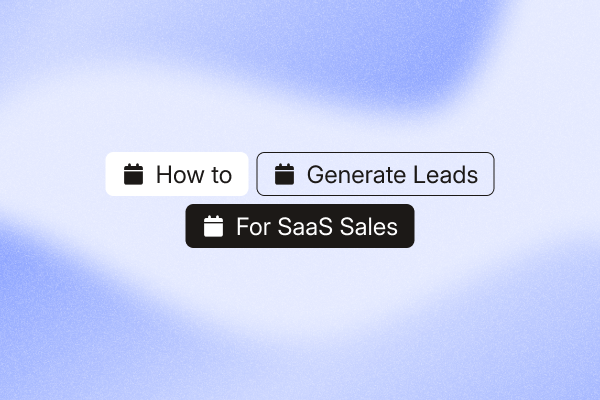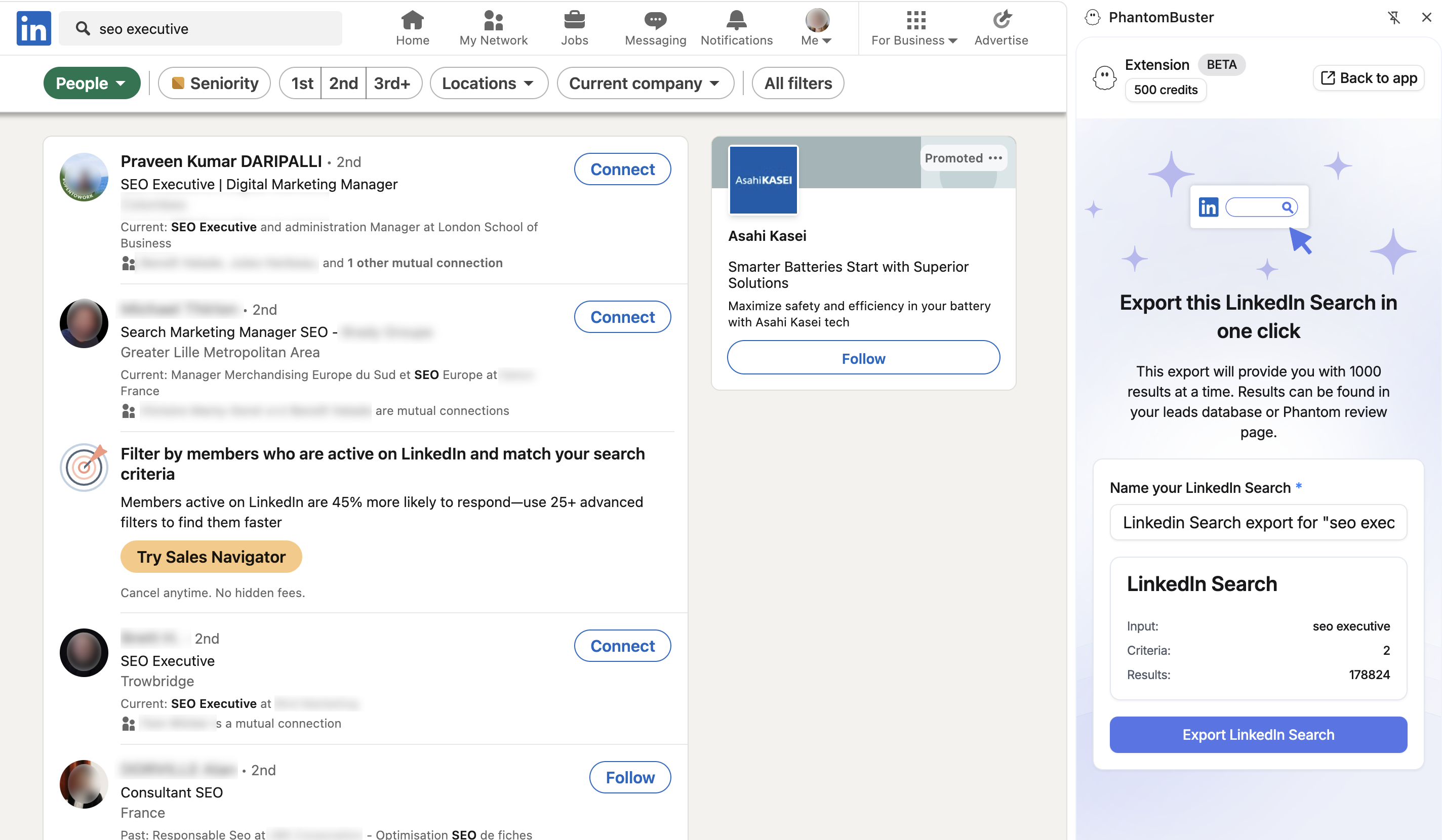Building a consistent pipeline of qualified leads is the foundation of successful SaaS sales. You need repeatable tactics that create meetings and opportunities this quarter, not generic marketing ideas. This guide focuses on actions your reps can run this week.
You’ll learn how to build an ICP-driven LinkedIn list, find verified emails, and run a 6-step outreach sequence that books meetings and moves SQLs into pipeline.
Foundation: Setting up your SaaS lead generation strategy
One of the most common mistakes in how to generate leads for SaaS sales is skipping the groundwork and jumping straight into tools and outreach. Without a solid foundation, even the best tactics won’t convert, especially in long-cycle, multi-stakeholder SaaS deals.
Define your ideal customer profile for effective lead generation
Your Ideal Customer Profile (ICP) determines who you reach out to, what you say, and how likely they are to convert. In SaaS, effective lead generation focuses on accounts with budget, urgency, and clear product fit.
Start by reviewing your highest-LTV customers with shorter sales cycles. Look for shared traits across:
- Company size: e.g. 50–500 employees scaling sales or marketing
- Industry: B2B SaaS, fintech, vertical SaaS niches
- Tech stack: HubSpot, Salesforce, Segment
- Triggers: New funding, team growth, leadership changes
- Location: Match territories or compliance zones
- Decision structure: Clear buying committees and budget ownership
Bad ICP example:
“Marketing teams at mid-size tech companies.”
Good ICP example:
“Revenue Operations leaders at B2B SaaS companies (100–500 employees) using HubSpot or Salesforce, actively hiring SDRs or investing in demand gen.”
The more precise your ICP, the easier it becomes to filter, personalize, and close.
Understand the SaaS lead generation process
Unlike one-call-close models, SaaS lead generation involves multiple touchpoints and stakeholders across a longer evaluation period. A good sales process doesn’t just generate leads. It guides them from first interest to close.
Start by understanding the difference between MQLs and SQLs:
- MQLs are leads showing interest through gated content, trials, or webinar signups
- SQLs have been qualified by sales, typically through a call or firmographic fit, and show real buying intent
Progressing leads from MQL to SQL depends on your ability to target the right persona and deliver relevance throughout the funnel.
Typical stakeholders in SaaS lead generation:
- Champion: Internal advocate pushing the deal forward
- Economic buyer: Decision-maker who controls the budget
- Technical evaluator: Ensures your product fits with existing systems
- End users: Influence adoption and day-to-day satisfaction
- Legal/procurement: Approves contracts and vendor compliance
Set up measurement frameworks for your lead generation efforts
Don’t just track lead volume. Focus on sales pipeline quality and efficiency.
- Lead source attribution: Which channels bring high-fit SQLs
- Conversion rates: MQL → SQL → opportunity
- Time to qualification (TTQ): How fast reps move leads
- Cost per lead: By channel and segment
- Revenue contribution: Pipeline value per lead source
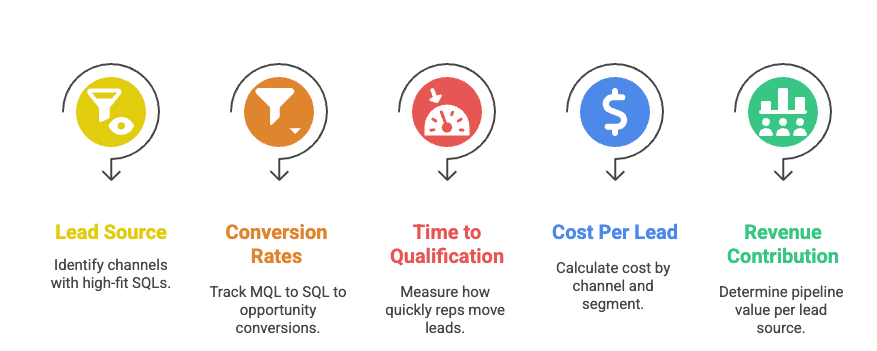
Double down on sources with >20% MQL→SQL conversion and pause any channel with cost per lead above target or TTQ >7 days.
Build a LinkedIn-first outbound system
Static lists go stale fast in SaaS. Build from live profiles and recent activity. If your goal is to generate leads for SaaS sales efficiently, you need a modern outbound system that gives you real-time visibility into who to contact, why now, and how to start the conversation.
Why LinkedIn beats traditional databases
LinkedIn is often the most up-to-date source of prospect data, since titles and team changes update in near real time. You can confirm current roles, see recent activity, and spot team changes as they happen.
Many reps report higher reply rates on LinkedIn when they segment tightly and test messaging.
With filters for job title, company size, region, tech stack, and recent activity, you can build a high-intent lead list in minutes.
Example filters for a Head of Growth ICP:
- Title contains “Head of Growth” or “VP Marketing”
- Company size: 51–200 employees
- Keywords: “ABM”, “HubSpot”, “pipeline”
- Location: North America
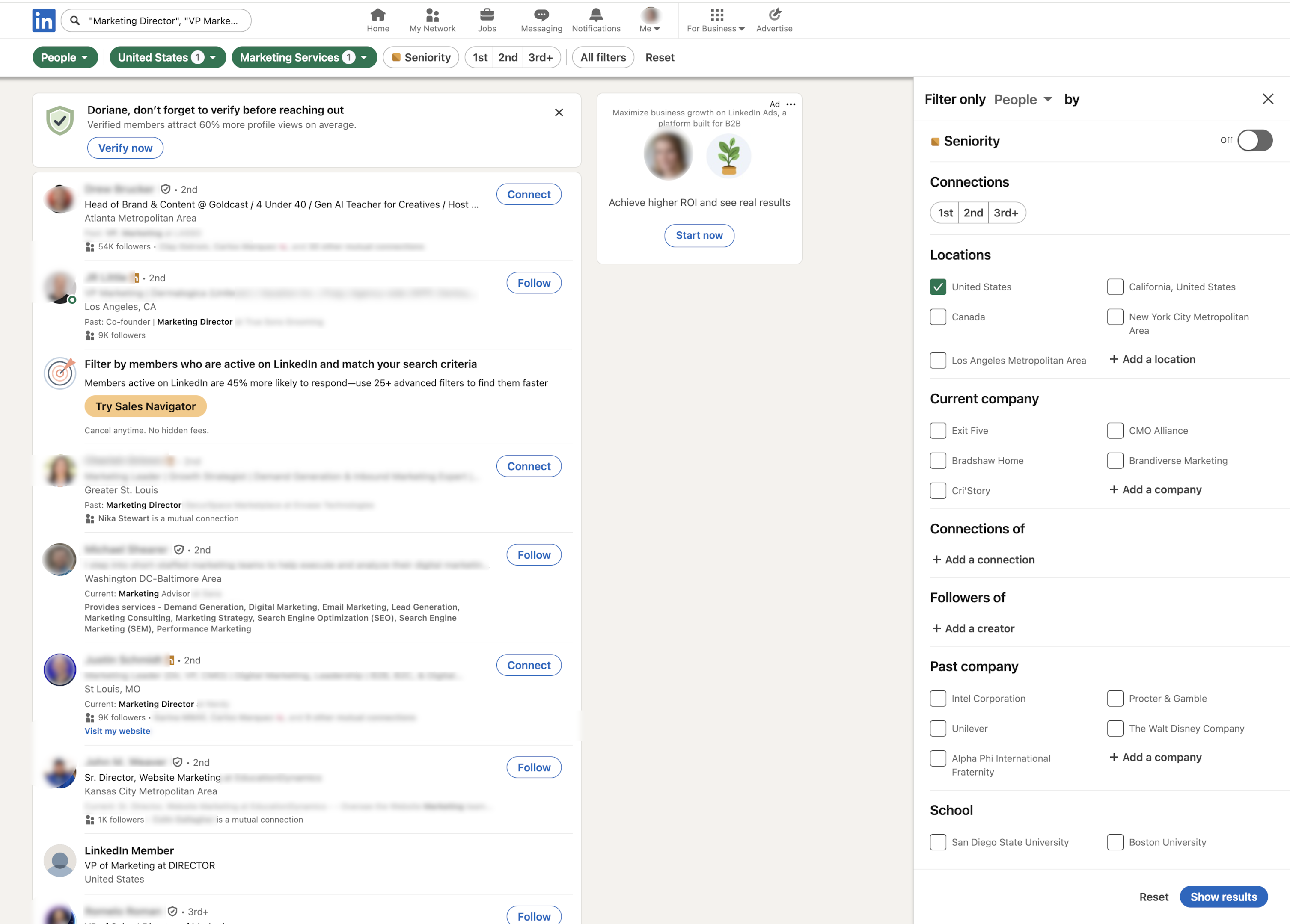
Pro tip: Use PhantomBuster’s LinkedIn Search Export automation to export filtered results, then the LinkedIn Profile Scraper to capture public role details and context. Together, these automations build a clean, enriched list.
Building targeted prospect lists
Most SDRs waste hours on generic databases or low-context research. With live LinkedIn profiles, you get relevant context up front, right where your prospect is sharing it.
When a profile mentions “Scaling with Marketo + HubSpot” or “Grew inbound pipeline 3×”, that’s your signal. These clues help tailor your outreach without guessing.
PhantomBuster converts public signals into structured lead data and can pass records to your verifier (e.g., Dropcontact).
Advanced targeting strategies (ranked by signal strength):
- Recent job changes (highest signal): Indicates potential for new tool adoption. Look for “Started new position” in PhantomBuster exports.
- Company growth (high signal): Suggests increased budget availability. Filter by recent funding or headcount growth.
- Tech stack mentions (medium signal): Reveals category readiness. Search profile headlines and bios for tool names.
- Event mentions (medium signal): Shows high intent or buying cycles. Track conference attendance or webinar participation.
- Content engagement (lower signal): Signals active learning or pain. Monitor post interactions and shares.
Email finding and verification
Once you’ve identified high-fit potential leads, you need valid contact information to start outreach. Combining multiple sources is the best way to maximize email match rates and deliverability.
Use only publicly shared contact details and follow LinkedIn’s terms. Fill gaps with verified providers. Run this via PhantomBuster’s email enrichment automations so records stay compliant and validated.
Email finding workflow:
- Extract public emails from LinkedIn profiles
- Use domain-based finders to predict company email patterns
- Cross-check against enrichment databases for verification
- Validate all emails before outreach
- Tag emails by confidence level to manage risk
Pro tip: PhantomBuster’s LinkedIn profile data export collects public contact details when users share them.
Multi-channel outreach sequences
Modern SaaS buyers don’t respond to generic email blasts. A multi-channel approach, starting with a warm LinkedIn touch, gets you on the radar before you ever hit their inbox.
Use LinkedIn for visibility and trust-building. Email for value. And phone for priority leads.
Design your sequence to educate, not just pitch. Reference their recent posts and activity. Send a relevant guide. Share a quick insight about their current stack. Focus on being helpful, not just “checking in.”
Example sequence:
- LinkedIn connection request with a short, personalized hook
- Email intro referencing recent activity or a tool mentioned on their profile
- LinkedIn follow-up with a relevant article or framework
- Phone call for high-intent leads showing engagement
- Follow-up email with case study from a similar company
- Final message with a clear ask or next step
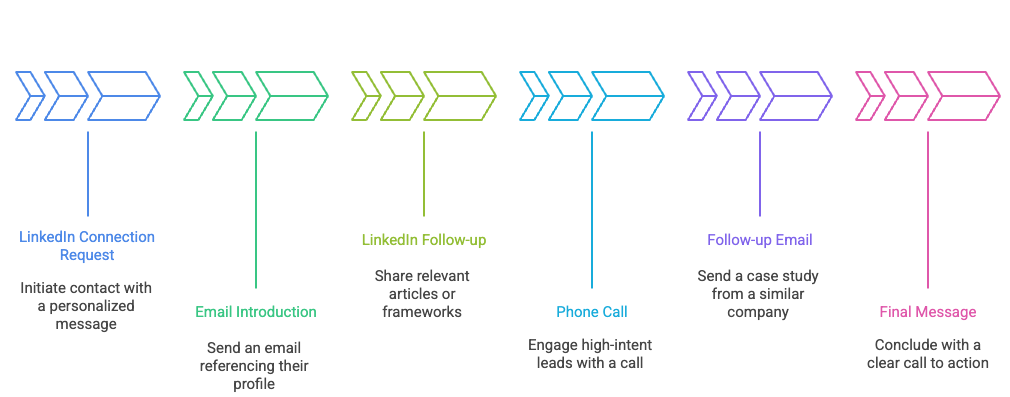
Pro tip: Use PhantomBuster’s LinkedIn Outreach automation to schedule multi-step LinkedIn touches.
Important: Keep daily actions within human-like limits, use only public data, and follow LinkedIn’s terms. Responsible automation protects your account and maintains deliverability.
Phone number extraction for multi-channel approach
For high-priority leads, a quick call often works better than a third follow-up email. But that only works if you’ve got the right number and a reason to use it.
Only capture publicly shared numbers and follow regional consent laws. When needed, enrich via compliant providers and label confidence.
Content marketing that supports your SaaS lead generation efforts
Content marketing for SaaS businesses should directly support your lead generation strategy, raising awareness, building trust, and giving your sales reps tangible value to reference in outreach.
Creating valuable content for sales conversations
Create implementation guides, not just traffic-oriented posts. These assets give SDRs a reason to follow up, add credibility, and move prospects forward.
Content that solves role-specific problems performs best. Think guides and case studies.
By weaving these assets into outreach cadences (e.g., “We helped a similar team cut onboarding time. Want the guide?”), reps can improve reply and conversion rates meaningfully.
Search engine optimization for SaaS lead generation
A strong SEO strategy targets high-intent, problem-specific keywords, the ones prospects use when actively evaluating solutions.
Optimize for phrases like:
- “Best onboarding tool for SaaS”
- “HubSpot alternative for mid-market”
- “How to reduce churn in SaaS onboarding”
These are discovery signals. Prospects using them are farther down the funnel and more likely to convert when they enter your sequence.
Social media marketing efforts for lead generation
Engaging with your audience on social media platforms or forums like LinkedIn, Reddit, and Slack groups keeps you visible and builds trust ahead of outreach.
SEO, blogging, and an organic presence on LinkedIn matter. Know where your target audience hangs out.
Another technique comes from Matt Lakajev on LinkedIn: Make your lead magnet clear, single-CTA, backed by social proof, and explicit about what’s inside.
Building these elements strengthens both your content and landing pages, making your outreach inherently stronger.
Lead magnets to capture leads effectively
Strong lead magnets do more than collect emails. They kick off qualified sales conversations. Think tools and content that solve real problems upfront and naturally pull prospects toward your solution.
Start with one or two based on funnel stage:
- Bottom-of-funnel (BOFU): ROI calculators to show cost-saving potential
- Middle-of-funnel (MOFU): Setup checklists or onboarding templates
- Also effective: Free tools or product samples tied to your core offer
- For education: In-depth guides or comparison sheets
- For engagement: Webinars or workshops with clear takeaways
Pro tip: Pair each lead magnet with a LinkedIn and email follow-up that references the asset.
Advanced SaaS lead generation strategies for business growth
Once your outbound system is running, add these advanced strategies to grow pipeline with quality and scale. These go beyond typical prospecting, focusing on high-value, multiplier, and network-driven growth.
Account-Based Marketing (ABM) for VIP accounts
ABM is all about zeroing in on a shortlist of high-value companies (often called “whales”) and weaving personalized engagement across channels.
Why it matters:
- 85% of marketers say ABM delivers higher ROI than other tactics
- 72% of companies report better account engagement with ABM compared to standard marketing channels
Example play:
- Identify 20 accounts meeting ICP plus funding or growth triggers
- Use PhantomBuster’s LinkedIn Search Export and enrichment automations to build and validate executive contact lists, then push them to your outreach sequence
- Run outreach not just via email and LinkedIn, but include tailored content like executive summary guides or ROI worksheets
Referral programs: scaling with trust
Referral leads typically convert better than cold outreach. Plus, referred customers have a 37% higher retention rate and 25% higher LTV. That’s because they arrive with trust baked in.
Tactic:
- Offer existing users discounts or credits for successful referrals
- Equip customers with shareable content they can pass easily
- Activate internal referrals by running incentives for cross-functional teams
Product-led growth integration for lead generation
PLG relies on self-serve experiences to attract and qualify leads naturally via free tiers or trials.
Amplify PLG with:
- Onboarding triggers (e.g., >3 users, >5 sessions) for outbound outreach
- In-product messaging to turn active users into SQLs
- Behavioral signals: Free-trial engagement can indicate higher conversion likelihood
Trigger follow-ups from behavior, not assumptions. That gives reps a warm, engaged entry point.
Industry events and networking for lead generation
In SaaS sales, face-to-face still matters, especially when you’re targeting mid-market to enterprise deals. Participating in niche industry events and conferences often yields much higher lead quality than mass trade shows.
Data shows that executive-level events can convert leads into MQLs at rates around 50–56%. That’s because attendees are actively evaluating solutions and ready to engage.
Actionable tactics:
- Target smaller, vertical-specific events that attract your ICP.
- Capture engagement (e.g., attendees, webinar participants, panel interactions).
- Use PhantomBuster to collect public attendee or commenter lists, then feed them into your outreach automation.
Paid advertising campaigns for immediate lead generation
If you need leads quickly, combine high-intent search with precise LinkedIn targeting and a follow-up workflow. SaaS teams get the best results by activating downloaded content through systematic follow-up.
Here’s what works:
- Search intent first: Use bottom-of-funnel queries like “alternatives to [X] SaaS” or “best CRM for [industry]” to reach buyers already in decision mode.
- Offer value, not demos: Lead magnets like ROI calculators or implementation guides convert better than demo CTAs, especially in paid formats.
- Build retargeting flows: If someone clicked an ad, viewed your pricing page, or downloaded content, hit them again via LinkedIn or email. That second touch often outperforms the first.
Pro tip: Retargeting with relevant content often outperforms the first touch, especially when you reference the prior interaction (e.g., “Saw you downloaded our guide”).
FAQ
What’s the most effective lead generation strategy for SaaS sales?
For many SaaS teams, a LinkedIn-first outbound motion performs best because job data and activity are current. It delivers high quality leads by combining real-time job data, professional activity, and context. For SaaS outbound sales teams, this approach outperforms traditional lead generation campaigns by helping you generate more qualified leads who are actively working on the problems your SaaS solution solves.
Pair LinkedIn with PhantomBuster’s prospecting automations to scale outreach while keeping messages personalized. This strategy consistently helps sales teams generate new leads that convert faster and lead to paying customers.
How many qualified leads should a SaaS sales rep generate per week?
Set a weekly goal that matches your ACV and cycle. For example, aim for 20–40 SQL-worthy leads for mid-market deals. B2B SaaS lead generation is about lead quality, not just volume. If you’re targeting relevant leads with clear pain points, a smaller number can drive better sales growth.
What’s the best way to find email addresses for SaaS prospects?
Your lead generation process should start by extracting publicly available emails from LinkedIn profiles of potential leads. Then, enrich those with tools like Dropcontact or Hunter.io. Verify with multiple data providers and validation tools to protect deliverability. This approach is a proven way to generate high quality leads without relying on stale databases.
How long should SaaS outreach sequences be?
An effective lead generation sequence for SaaS includes 5–7 touchpoints over 3–4 weeks using a mix of LinkedIn, email, and phone. Make each message count by sharing valuable content, relevant case studies, or insights tied to the prospect’s role, industry, or sales process stage.
What research should I do before contacting SaaS leads?
Before reaching out to a potential customer, research their:
- Company growth or recent funding
- Technology stack
- Job change history
- Engagement on company and personal social profiles
This lets you personalize outreach, show that you understand their pain points, and position your SaaS company as the right fit. Targeting the right audience with relevant, contextual messaging is what turns potential customers into satisfied customers.
How often should I update my prospect lists?
Update your prospect lists at least monthly, or weekly in fast-moving segments. LinkedIn data shifts fast in the SaaS market. People change roles, companies raise funding, and teams evolve. Keeping your prospect list fresh ensures your lead generation efforts always target engaged leads with current needs.
